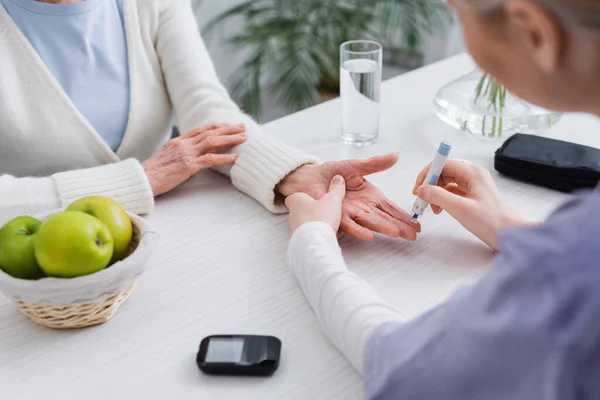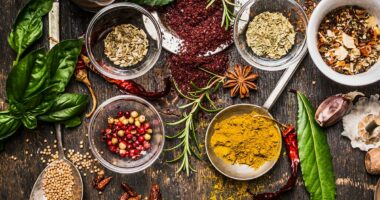Share this @internewscast.com
Insulin resistance (IR) occurs when the cells in your body no longer respond appropriately to the hormone insulin, responsible for regulating blood glucose levels.
To compensate, the pancreas increases insulin production, aiming to achieve normal blood glucose levels. However, this elevated insulin output can lead to desensitization of the cells, requiring progressively more insulin to maintain normal blood glucose levels. If left unaddressed, this desensitization can contribute to the development of metabolic conditions such as Type 2 Diabetes and heart disease.
Notably, IR often presents few noticeable symptoms, making it challenging for individuals to recognize its presence until years later. Given that reversing the adverse effects of IR is more achievable in its early stages, detecting it promptly becomes crucial.

Common symptoms of insulin resistance
While it can be hard to initially detect IR, certain symptoms or warning signs may indicate its presence. Here are some of the most common insulin resistance symptoms:
- Excessive hunger and thirst: If your body isn’t producing enough insulin (the hormone that unlocks cells so glucose can enter them), excess glucose builds up in your blood. This taxes your kidneys (which are responsible for filtering out this extra glucose via your urine) by forcing them to pull water from your body — including tissues — to create enough urine to carry out the additional glucose. This can lead to you feeling excessively thirsty or hungry.
- High fasting blood sugar levels: When your pancreas can’t make enough insulin to keep your blood sugar levels in a healthy range, it leads to elevated blood sugar levels and, over time, prediabetes and Type 2 Diabetes. Your fasting blood glucose is considered high if it remains elevated for 8-10 hours after your last meal, or if a CGM measures it at around >140mg/dL or >7.8mmol/L approximately 2 hours after a meal.
- Abnormally high blood pressure: Research indicates that insulin can cause your body to retain sodium and water, which can lead to high blood pressure that burdens your heart [1]. While the factors that lead to high blood pressure are still debated, there is a link between insulin resistance and high blood pressure, so it’s important to realize that you may be at increased risk for IR if you have high blood pressure [2].
- Unexplained weight gain and difficulty losing weight: When your cells stop responding appropriately to insulin, your body’s glucose levels become elevated, promoting fat storage in your liver. This cycle repeats itself over and over, causing you to gain weight and have difficulty shedding it.
11 Surprising Insulin Resistance Symptoms
Insulin resistance is a condition where your body’s cells don’t respond properly to the hormone insulin. This can lead to high blood sugar levels, which can increase your risk of prediabetes, type 2 diabetes, and other health problems.
While some symptoms of insulin resistance are well-known, such as fatigue and increased thirst, others are more surprising. Here are 11 surprising symptoms of insulin resistance:
1. Skin tags:
Skin tags are small, fleshy growths that can appear on the neck, armpits, and groin. They are more common in people with insulin resistance and can be a sign of high insulin levels.
2. Hair loss:
Hair loss can be caused by a variety of factors, including insulin resistance. If you are noticing thinning hair or bald spots, it’s important to see a doctor to rule out any underlying medical conditions.
3. Sugar cravings:
People with insulin resistance may crave sugary foods and drinks more often than others. This is because their bodies are not able to use glucose properly for energy.
4. Constant lethargy or fatigue:
Insulin resistance can make you feel tired and sluggish all the time. This is because your body is not able to convert glucose into energy efficiently.
5. Darkening of the skin:
Acanthosis nigricans is a condition that causes the skin to darken in patches, particularly in the folds of the neck, armpits, and groin. It is a common sign of insulin resistance and can be a precursor to diabetes.
Read Related Also: Stair Climbing Can Lower Your Heart Disease Risk, Study Says
6. Slow-healing wounds:
People with insulin resistance may have difficulty healing from wounds, such as cuts and scrapes. This is because high blood sugar levels can damage blood vessels and nerves.
7. Polycystic ovary syndrome (PCOS):
PCOS is a hormonal disorder that can cause irregular periods, excess hair growth, and weight gain. It is also a risk factor for insulin resistance and type 2 diabetes.
8. Erectile dysfunction (ED):
ED is a common problem in men with insulin resistance. This is because high blood sugar levels can damage nerves and blood vessels, which are necessary for erections.
9. Fatty liver disease:
Fatty liver disease is a condition where fat builds up in the liver. It is a risk factor for insulin resistance and type 2 diabetes.
10. Sleep apnea:
Sleep apnea is a condition where breathing repeatedly stops and starts during sleep. It is more common in people with insulin resistance and can be a sign of high blood sugar levels.
11. High cholesterol:
High cholesterol is a risk factor for heart disease, stroke, and other health problems. It is also more common in people with insulin resistance.
If you are experiencing any of these symptoms, it is important to see a doctor to get a diagnosis and start treatment. Insulin resistance is a serious condition, but it can be managed with diet, exercise, and medication.
Here are some additional tips for managing insulin resistance:
- Eat a healthy diet that is low in processed foods, sugary drinks, and unhealthy fats.
- Exercise regularly. Aim for at least 30 minutes of moderate-intensity exercise most days of the week.
- Lose weight if you are overweight or obese. Even a small amount of weight loss can help improve insulin sensitivity.
- Manage stress. Stress can worsen insulin resistance. Find healthy ways to manage stress, such as yoga, meditation, or spending time in nature.
- Get enough sleep. Aim for 7-8 hours of sleep each night.
By making these lifestyle changes, you can improve your insulin sensitivity and reduce your risk of developing type 2 diabetes and other health problems.
Key Takeaways
Skin tags, hair loss, sugar cravings, and constant lethargy or fatigue can all be subtle early warning signs of insulin resistance. If you are experiencing some of these symptoms, make an appointment with your doctor to see if IR might be to blame. If it is, here are some of the proactive steps you can take to help reverse it:
- Manage Your Weight: Maintaining a healthy weight for your body type is one of the best ways to prevent (or reverse) IR. Learn more about weight loss myths and the relationship between glucose and weight loss.
- Aim for a Healthier Diet: The adage “you are what you eat” holds when it comes to protecting yourself against the negative impacts of IR. Eat healthy foods like whole grains, nuts, fruits, vegetables, and lean meat, and experiment with time-restricted eating (TRE) or eating according to your circadian rhythm to help regulate your blood glucose levels.
- Create an exercise routine: Practicing a combination of resistance training and aerobic exercise (2-3 days per week of running, walking, or cycling, and 1-2 days per week of lifting weights) can have a significant impact on your metabolic health. While there are various pros and cons associated with working out at various times of the day, the best type of exercise (and time to do it) is ultimately whichever one you will stick with.
- Glucose monitoring: A continuous glucose monitor (CGM) is one of the best ways you can understand your glucose levels in real-time and how they fluctuate based on your diet and lifestyle. Since insulin resistance often presents no noticeable symptoms, getting personalized data from a CGM can be eye-opening and empowering — allowing you to figure out concrete steps to taking control of your health and reversing insulin resistance if you have it.
References:
I hope this information is helpful. Please let me know if you have any other questions.














